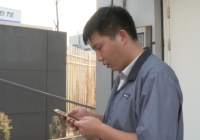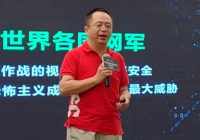中国日报消息,8月1日,清华大学研制出的一款自行车登上了最新一期全球顶尖期刊《自然》杂志(Nature)的封面!
跟CD君先来看看,自行车“成精”后的样子。自我平衡↓↓

绕开障碍物↓↓

S型路线↓↓

向左转↓↓

这辆无人自行车可实时感知周围环境。它可以在跟随前方试验人员的同时自动进行避障操作。装上芯片后,自行车可以根据语音指令、视觉感知的反馈产生实时信号,从而对电机进行控制,以达到保持平衡,改变行进状态。
自行车为什么这么“听话”?吃了“仙丹”?别说,还真是。而且清华大学科学家研制的“仙丹”还是中国制造、全球首款。科学家团队在自行车里内部装了一款名叫“天机”(Tianjic)的人工通用智能芯片。

这是一款中国自主研制的芯片,更是全球首款异构融合类脑芯片。8月1日,这款由清华大学类脑计算研究中心施路平教授带领团队研制出的芯片,登上了最新一期全球顶尖期刊《自然》杂志(Nature)的封面!

据悉,凭借这项研究,施路平团队实现了中国在芯片和人工智能两大领域Nature杂志论文零的突破。

Nature封面文章 | 中国团队的“天机芯”架起了通用人工智能领域机器学习和神经科学的桥梁
该研究团队的领导者是清华大学精密仪器系教授、类脑计算中心主任施路平,成员来自清华大学、北京灵汐科技、北京师范大学、新加坡理工大学和加州大学圣塔芭芭拉分校等科研机构。
七年,磨出一颗中国“芯”
历时7年,施路平教授带领的团队,“打磨”出了中国人自己的通用人工智能(AGI)芯片——“天机芯”。
“天机芯”作为一款新型计算机芯片,可用于实时物体检测、跟踪、语音识别、避障和平衡控制,是世界首款异构融合类脑芯片,也是世界上第一个既可支持脉冲神经网络又可支持人工神经网路的人工智能芯片。

(施路平团队发表的论文:《面向通用人工智能的混合天机芯片架构)据Nature报道,当前,人工智能芯片发展有两大主流方向,一种是以神经科学为基础,试图建构模拟大脑的电路;另一种以计算机科学为基础,通过计算机来执行机器学习算法。
There are two main approaches to developing artificial general intelligence. One is rooted in neuroscience, and attempts to construct circuits that closely mimic the brain. The other is grounded in computer science, and uses computers to execute machine-learning algorithms.
然而,由于算法和模型的差别,当前人工智能芯片均只支持人工神经网络或脉冲神经网络,难以发挥计算机和神经科学两个领域的交叉优势。
但“天机芯”与以往的研究不同。
施路平教授表示,“我们做的是类脑(研究),是借鉴脑科学的基本原理,凝练出一些指导计算架构发展的新规律。”
在此基础上,该团队提出了符合脑科学基本规律的新型类脑计算架构——异构融合的天机类脑计算芯片架构,可通过资源复用,只需3%的额外面积开销即可同时运行计算机科学和神经科学导向的绝大多数神经网络模型,支持异构网络的混合建模,形成时空域协调调度系统,发挥它们各自的优势,既能降低能耗,提高速度,又能保持高准确度。

(“天机芯”综合两种运作方式)也就是说,“天机芯”能将两种运作方式集合在一个混合平台中。它具有有多个功能核心,可轻松实现重新配置,使其能同时运行机器学习算法和大多数神经网络模型。
In this week's issue, Luping Shi and his colleagues reveal the Tianjic chip — an electronic chip that integrates the two approaches into one hybrid platform. The Tianjic chip has multiple functional cores that are readily reconfigurable, enabling it to accommodate both machine-learning algorithms and brain-inspired circuits.

(“天机芯”的设计)
“这只是非常初步的一个研究,但这项研究或能为面向人工通用智能计算平台的进一步发展起到促进作用。”施路平表示。
据一家专注于人工智能的网站Synced Review报道,“天机芯”关键创新之处在于其统一的功能核(FCore)。该功能核结合了人造神经网络和生物网络的基本构建基块——轴突、突触、树突和胞体。
A key innovation from the research team is Tianjic's unified function core (FCore) which combines essential building blocks for both artificial neural networks and biologically networks — axon, synapse, dendrite and soma blocks.
“天机芯”采用28纳米工艺制程打造,由156个功能核组成,包含约4万个神经元和1千万个突触,其大小为3.8×3.8平方毫米。
The 28-nm chip consists of 156 FCores, containing approximately 40,000 neurons and 10 million synapses in an area of 3.8×3.8 mm².
研究团队还展示了“天机芯” 与GPU相比较的优越性:“天机芯”的吞吐量比GPU高1.6-100倍,能效提高12-10000倍。
The research team also showcased the superior performance of Tianjic compared to GPU, where the new chip achieves 1.6–100 times better throughput and 12–10000 times better power efficiency.

(“天机芯”和测试板)自行车虽小,“五脏”俱全Nature在对该研究的介绍中肯定了“天机芯”应用于无人驾驶自行车的试验。研究人员将芯片安装到无人自行车,来证明该芯片的强大功能和潜力。这款无人自行车能自我平衡,具有声控功能,可探测并避开障碍物。这都是“天机”芯片能同时处理多种算法和模型的强大功能。
The researchers demonstrate the potential of this approach by incorporating one of their chips into a riderless autonomous bicycle, which can self-balance, is voice controllable and can detect and avoid obstacles, all as a result of the Tianjic chip's simultaneous processing of versatile algorithms and models.Synced Review报道称,这款搭载“天机芯”的无人自行车系统,还装备了IMU传感器、摄像头、转向电机、驱动电机、调速电机和电池等,使其能执行实时目标探测、跟踪、语音命令识别、过障、自动避障、自平衡和自主决策等行为。
Equipped with the Tianjic chip and IMU sensor, a camera, steering motor, driving motor, speed motor and battery, the bicycle was tasked with performing functions such as real-time object detection, tracking, voice-command recognition, riding over a speed bump, obstacle avoidance, balance control and decision making.

(无人自行车设计)
研究团队开发了多种神经网络来完成每项任务。这些模型经过预先训练并编程到“天机芯”上,“天机芯”可并行处理这些模型,实现多种模型之间的无缝片上通信。
The research team developed a variety of neural networks (CNN, CANN, SNN and MLP networks) to enable each task. The models were pretrained and programmed onto the Tianjic chip, which can process the models in parallel and enable seamless on-chip communication across different models.

施路平认为,人工通用智能芯片能够成功,多学科深度融合才是关键。
研究团队介绍,他们希望“天机芯”可被用于无人驾驶汽车和智能机器人上。他们已经开始投入第二代芯片的研究,研发阶段预计会在明年初结束。
The research team told Chinese media they expect the Tianjic chip to be deployed in autonomous vehicles and smart robots. They have already started research on the next-generation chips and expect to close the R&D stage early next year.
加油!中国芯!
原标题:清华大学的这辆自行车“成精”了!“天机”在全球顶尖期刊“泄露”
【免责声明】上游新闻客户端未标有“来源:上游新闻-重庆晨报”或“上游新闻LOGO、水印的文字、图片、音频视频等稿件均为转载稿。如转载稿涉及版权等问题,请与上游新闻联系。































































